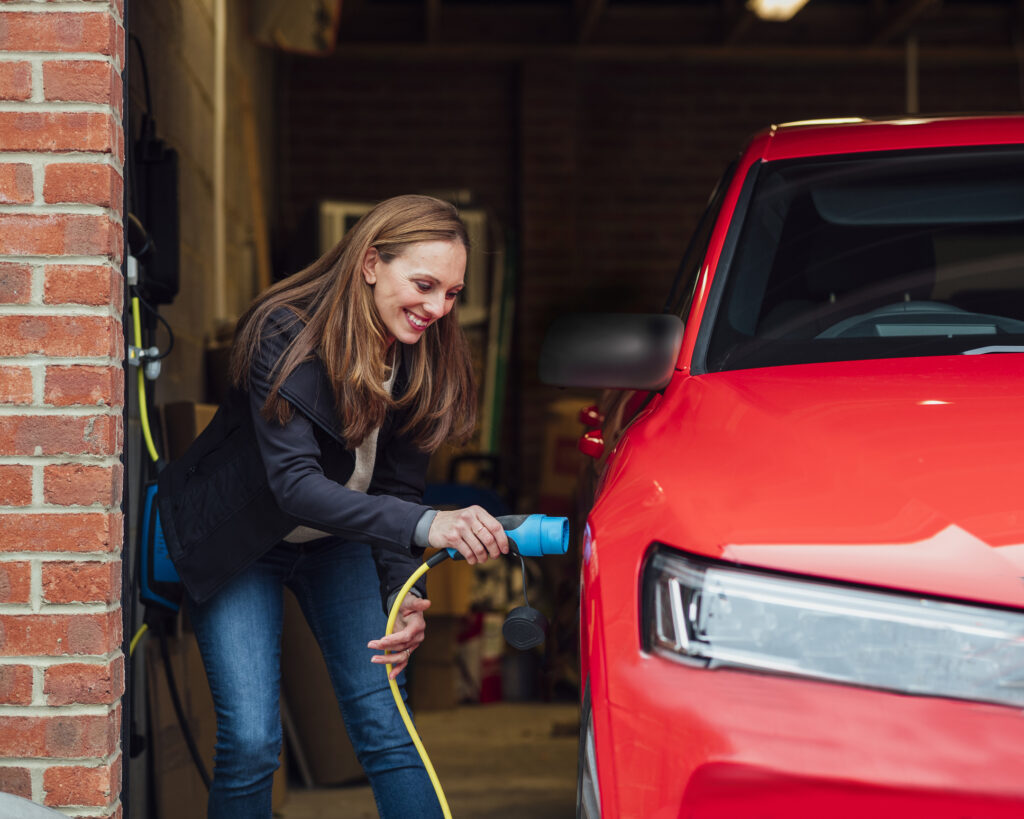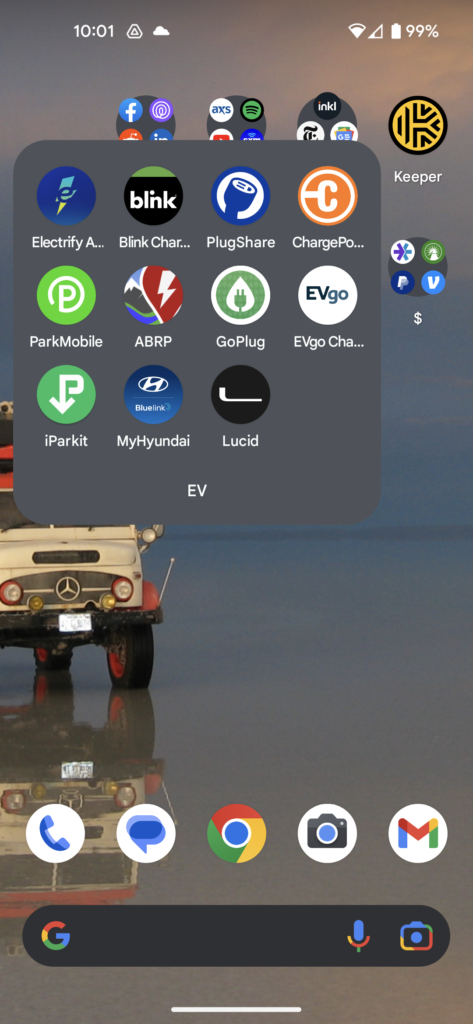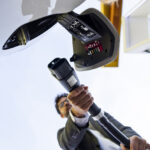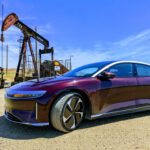TL;DR
The learning curve for driving electric is not steep nor particularly long. But it isn’t zero, either.
There are really only three things you really need to know after purchasing your first EV. First, you’ll want a place of your very own to charge. Next, you’ll want to download the most useful apps to make trip planning and charging easier. Lastly, use the buddy system: there is someone out there eager to help you get the most out of your EV, and finding them is easy.
The Nitty Gritty Details of Your New EV
Before You Leave the Dealership

Installing a Level 2 EVSE (charger) where you park your car each night is the single most important thing you can do to get ready to bring your new EV home. Photo credit: QMerit
Not to state the obvious, but an EV –even a plug-in hybrid– needs to be charged. We’ve all seen the video of the woman trying to gas up her Tesla. And while that video was obviously staged, there have been plenty of real-world examples of new EV owners not really understanding that an EV’s primary means of motivation relies on access to the power grid.
So before you leave the dealership with your shiny new EV, find a place you can call your very own to charge and get that space ready for your car. This takes some planning, so this step needs to happen before you even go to a dealership.
There’s a lot of assumption and nuance baked into the expectation that everyone considering an EV will be able to have a place of their own to charge. This week’s column is not meant to dive into the topic of how to drive electric if you live in an apartment complex with no access to overnight charging. And while it can (and has) been done, I do not recommend that for most people. The problem of charging equity is an important one that I spend a lot of time on, but it is a far larger topic than can be tackled in a weekly column.
Think of charging your car this way: most people reading this will own a smartphone. It’s a pretty convenient aspect of modern life, isn’t it? And you have a place to charge it. Probably several places. When it gets low on power, you just plug it in without a care in the world.
How would your smartphone experience change if you had to take it somewhere special to charge it every time your phone got low on power? Even if that special phone-charging place was just down the street, doing it every day (or even every third day) would quickly become a much-dreaded chore.
Charging your EV while you sleep is one of the biggest benefits of EV ownership. But if you’re not in a position to do that (or conversely charge while you work), do not underestimate the scope of keeping your first EV charged if you have to “go fill up” when your GOM starts creeping toward zero.
Ideally, you’ll want to install a Level 2 EVSE where you park for the night. Have a qualified electrician install the necessary wiring before you purchase your EV.
One key to enjoying your EV is not fretting over its next charge. You’ll thank me later.
There’s an App for That
Your first EV will come with an app of its own to help you control the car (for example, heating up the interior on a cold day, before you step outside). But there are loads of apps that will increase the usefulness of your new EV. I’ll list a few of my favorites below.

There are lots of EV-related apps – some more useful than others. Below we’ll discuss the ones I think everyone should have. Here’s a glimpse of my personal EV folder on my phone.
Plugshare
Back in the early days of EVs, Plugshare was more of what its namesake implies. Individual EV owners would list that they had an EVSE in their garage that was available for any other driver out there to use if needed. There is still a setting in Plugshare to list residential locations, but few people realize this is a thing, and fewer still list their homes as open. I’ve had people come to my home to charge before, and have also been welcomed to the homes of others while I charged my car. But that’s not what Plugshare is famous for today.
Plugshare is a bottoms-up database of locations where you can charge your car. This includes the obvious L2 or DCFC locations, but also less obvious things like if a plug (and what kind of plug) is available for “bring your own EVSE” situations. Further, Plugshare users rank their experiences and leave photos of the locations. Think of it as independent Amazon-type reviews for every charging location. You can filter locations by plug type, available power, or even if the location has a “Plugscore” above, say, 8 out of 10.
A Better Route Planner (aka ABRP)
We’ll cover how to plan an EV road trip in more detail in next week’s column, but in my view, ABRP is the standard by which all other planning tools should be judged. Plugshare has a road trip planning tool, as does Google Maps. But the versatility of ABRP makes it a clear leader. Select your EV (ABRP has a database of known variables, so once you select your EV, it knows battery size, efficiency, and so forth), your starting and ending location, and let it plan your trip. ABRP will automatically account for elevation gains and if you adjust the settings, it can even compensate for a roof-mounted box, weather, extra weight, and so forth. It’s invaluable for trip planning.
Network-Specific Apps
We are still in the Wild West days of the EV era; every network has its own app, and there is no such thing as roaming. And while there is a law (in California at least) that requires stations to accept a credit card without the overhead of an app, the reality is that station connectivity is far easier if you use the network-specific app.
Save some frustration and download the network-specific apps before you pull into a public charging spot hoping to use it. The biggest networks include ChargePoint, EVgo, and Electrify America. There are roughly 30 others, but those three represent about 90% of the market.
Set up an account from the comfort of your own home so you’re not fumbling with your phone in the rain or cursing at poor cell coverage. If that sounds like an oddly specific example, I’d like to say, in my defense, that I wish a column like this existed back in 2012.
It Takes a Village
Being an active member of a model-specific social media group can help with better understanding your first EV in many ways. This can be on Facebook, Reddit, or even an older-style message board forum; a model-specific community for your car exists in all of the above social media outlets, and members of that community are eager to help. I’m convinced these communities are the best way to learn the quirks and features of your car. Additionally, if you’re having a problem with your first EV, there is an excellent chance that someone has paved the road ahead and can help resolve your problem as quickly as possible.
Belonging to a model-specific social media group is especially important for EV owners, because typical dealerships can be a source of frustration regarding problems that may arise with an EV. This happens because the experience base of dealers and the technicians they employ is lacking when it comes to troubleshooting, for example, charging problems. For something as complex and sophisticated as an EV, you do not want the same person who tried to sell you an oil change to try and pinpoint your EV charging issues that ultimately turn out to be because of a bad ground on your home’s EVSE. This is exactly the prowess the Borg-like online community excels at and dealers just plain suck at.
A word of caution about social media groups, though. Certain EVs (cough, cough, Tesla) attract the adrenaline junkie segment of the population. It only takes a few to turn a valuable resource into a toxic dump. In these cases, regional groups tend to be more accommodating because there is far less anonymity, as the group becomes more focused on a specific geographic region.
That’s it—three simple but important ways to maximize the fun and usefulness of your new EV. Install an EVSE in a place you control and can easily access, download the most useful EV-related phone apps, and get involved in your first EV’s model-specific community. Oh, and put on your favorite playlist, turn it up to 11, and drive it until the wheels fall off!
Next week’s topic is: EV Road Trips: Surging Out of Your Comfort Zone.








0 Comments